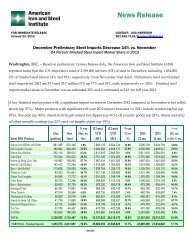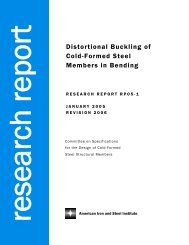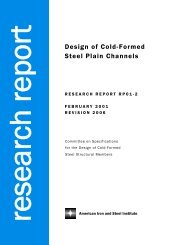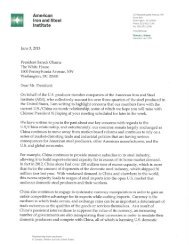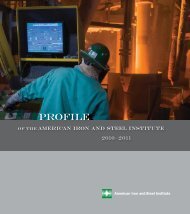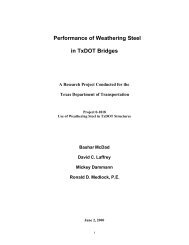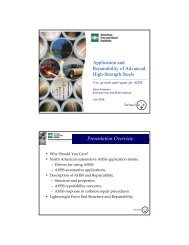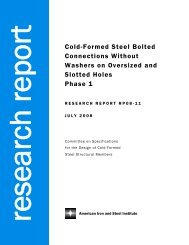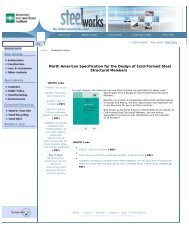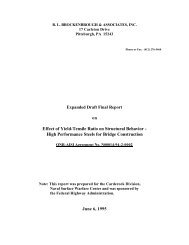Statistical Analysis of Structural Plate Mechanical Properties (Part 1)
Statistical Analysis of Structural Plate Mechanical Properties (Part 1)
Statistical Analysis of Structural Plate Mechanical Properties (Part 1)
Create successful ePaper yourself
Turn your PDF publications into a flip-book with our unique Google optimized e-Paper software.
CHAPTER 1<br />
INTRODUCTION<br />
1.1 INTRODUCTION<br />
The purpose <strong>of</strong> this research is to survey the mechanical properties <strong>of</strong> A572 and<br />
A588 plates produced in North America. The study focuses on three aspects: chemical<br />
properties, tensile properties, and toughness properties. Results from this study can be <strong>of</strong><br />
benefit to specification-writing bodies and other users interested in the variability <strong>of</strong><br />
mechanical properties <strong>of</strong> A572 and A588 plates. The results can also help update present<br />
databases on plate properties that do not include modern production techniques and new<br />
mills and producers.<br />
1.2 SCOPE OF RESEARCH<br />
The test results were supplied by a total <strong>of</strong> six mills from five producers in North<br />
America. Steel plates <strong>of</strong> both A572 and A588 grade from a total <strong>of</strong> 1,326 heats were<br />
analyzed. Overall statistical summaries were computed for carbon equivalent (CE), yield<br />
strength, tensile strength, yield to tensile ratio, and yield point to yield strength ratio.<br />
The statistical relationship between carbon equivalent and (i) yield strength; (ii)<br />
tensile strength; and (iii) yield to tensile ratio was also studied.<br />
A statistical analysis <strong>of</strong> the Charpy V-Notch toughness test results was conducted<br />
based on sixty-nine A588 and A572 steel plates from four <strong>of</strong> the six mills who<br />
participated in the survey. The study was conducted for three test temperatures (0°F,<br />
40°F, and 70°F), four thickness groups (T1 to T4, defined later), and two steel grades<br />
(A572 and A588). Additionally, a detailed study was conducted in order to compare the<br />
variability within a plate with the variability between plates.<br />
The effect <strong>of</strong> the selection <strong>of</strong> a reference location (from among the 7 possible<br />
sampled locations) with respect to absorbed energy was studied. This was done<br />
separately for low- and high-toughness plates. This effect <strong>of</strong> reference location was<br />
studied by computing the percentage <strong>of</strong> samples that had absorbed energy values greater<br />
than a specified level below the absorbed energy associated with the reference location.<br />
Finally, absorbed energy and lateral expansion were studied jointly in order to estimate<br />
2



